Evaluating the Role of Mental Health in Nursing and Patient Safety
VerifiedAdded on 2023/06/08
|10
|2124
|131
Report
AI Summary
This report explores the critical nursing care issue of mental health among nurses and its impact on patient safety and the quality of healthcare services. It addresses the prevalence of mental health issues among healthcare professionals, particularly nurses, and the potential consequences for patient care. The study investigates how nurses' mental health can interfere with patient treatment, the association between service quality and mental well-being, and the effects on patients' recovery. Data was collected through interviews with 20 nurses from various departments, combining qualitative and quantitative data. Findings indicate that a nurse's mental state can significantly influence patient outcomes, potentially leading to decreased quality of care and compromised patient safety. The report concludes that addressing and supporting the mental health of nurses is essential for maintaining a healthy work environment, improving productivity, and ensuring high-quality patient care within healthcare organizations. Desklib offers this report as a valuable resource for students, alongside a wide range of past papers and solved assignments.
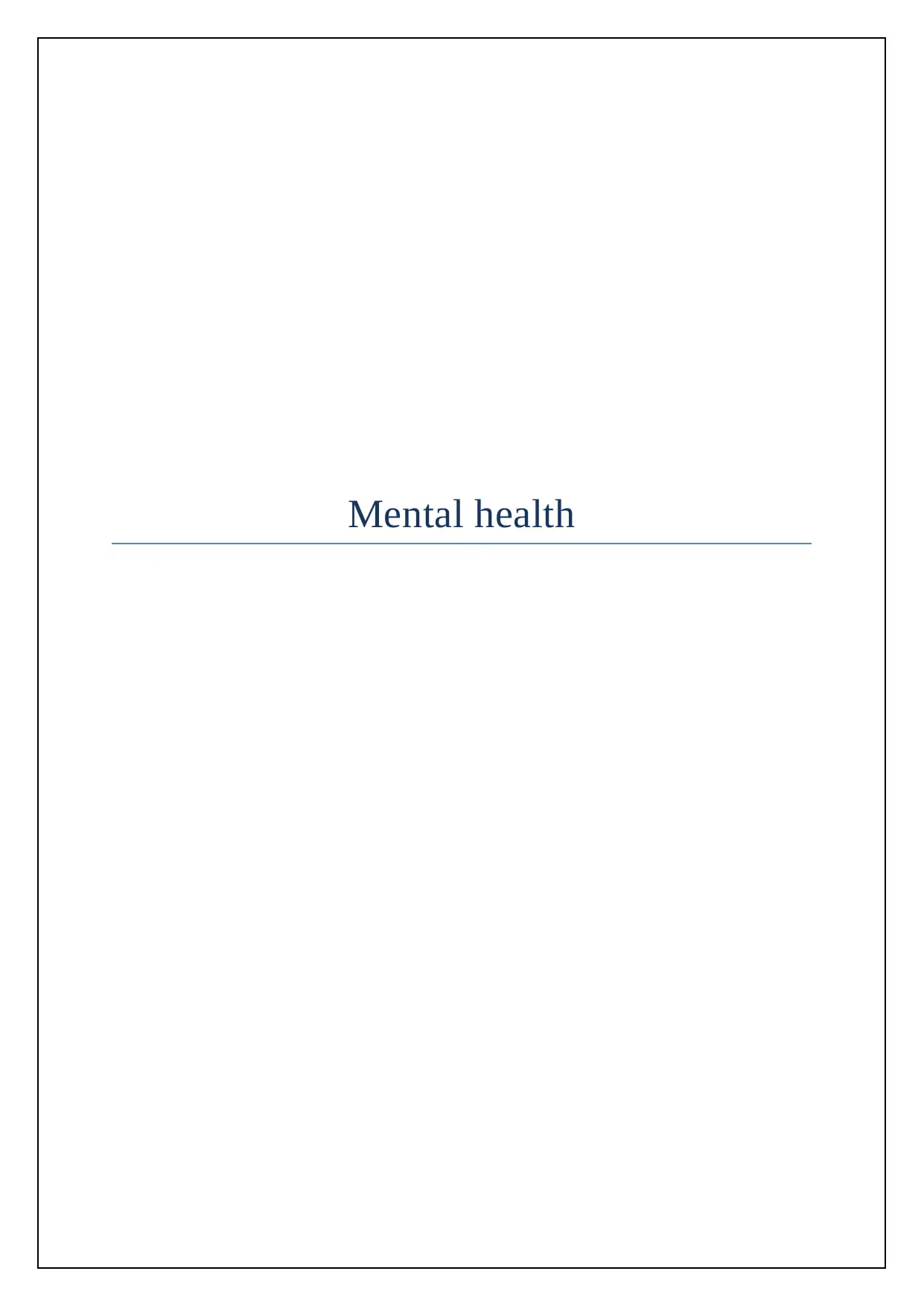
Mental health
Paraphrase This Document
Need a fresh take? Get an instant paraphrase of this document with our AI Paraphraser
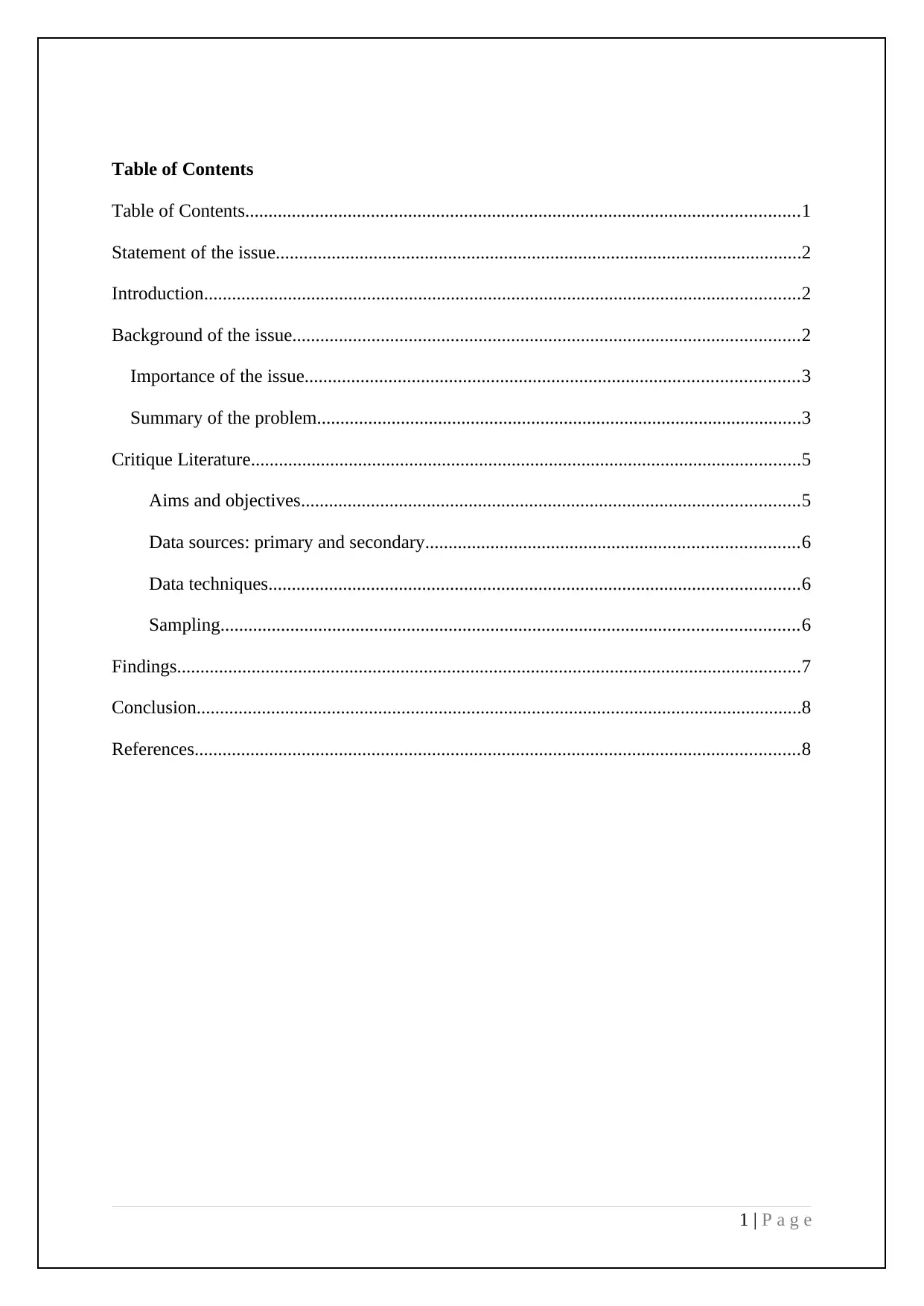
Table of Contents
Table of Contents.......................................................................................................................1
Statement of the issue.................................................................................................................2
Introduction................................................................................................................................2
Background of the issue.............................................................................................................2
Importance of the issue..........................................................................................................3
Summary of the problem........................................................................................................3
Critique Literature......................................................................................................................5
Aims and objectives...........................................................................................................5
Data sources: primary and secondary................................................................................6
Data techniques..................................................................................................................6
Sampling............................................................................................................................6
Findings......................................................................................................................................7
Conclusion..................................................................................................................................8
References..................................................................................................................................8
1 | P a g e
Table of Contents.......................................................................................................................1
Statement of the issue.................................................................................................................2
Introduction................................................................................................................................2
Background of the issue.............................................................................................................2
Importance of the issue..........................................................................................................3
Summary of the problem........................................................................................................3
Critique Literature......................................................................................................................5
Aims and objectives...........................................................................................................5
Data sources: primary and secondary................................................................................6
Data techniques..................................................................................................................6
Sampling............................................................................................................................6
Findings......................................................................................................................................7
Conclusion..................................................................................................................................8
References..................................................................................................................................8
1 | P a g e
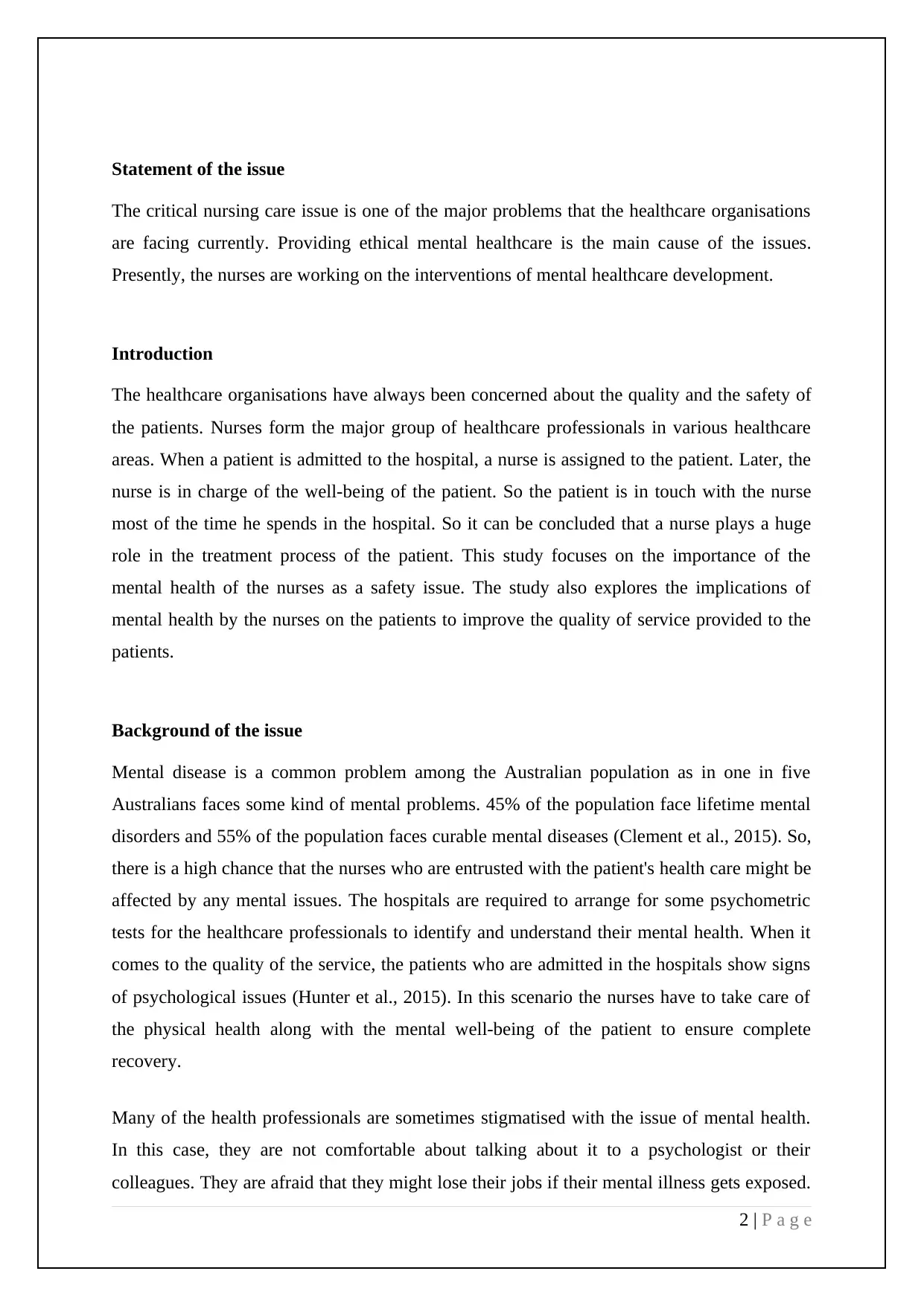
Statement of the issue
The critical nursing care issue is one of the major problems that the healthcare organisations
are facing currently. Providing ethical mental healthcare is the main cause of the issues.
Presently, the nurses are working on the interventions of mental healthcare development.
Introduction
The healthcare organisations have always been concerned about the quality and the safety of
the patients. Nurses form the major group of healthcare professionals in various healthcare
areas. When a patient is admitted to the hospital, a nurse is assigned to the patient. Later, the
nurse is in charge of the well-being of the patient. So the patient is in touch with the nurse
most of the time he spends in the hospital. So it can be concluded that a nurse plays a huge
role in the treatment process of the patient. This study focuses on the importance of the
mental health of the nurses as a safety issue. The study also explores the implications of
mental health by the nurses on the patients to improve the quality of service provided to the
patients.
Background of the issue
Mental disease is a common problem among the Australian population as in one in five
Australians faces some kind of mental problems. 45% of the population face lifetime mental
disorders and 55% of the population faces curable mental diseases (Clement et al., 2015). So,
there is a high chance that the nurses who are entrusted with the patient's health care might be
affected by any mental issues. The hospitals are required to arrange for some psychometric
tests for the healthcare professionals to identify and understand their mental health. When it
comes to the quality of the service, the patients who are admitted in the hospitals show signs
of psychological issues (Hunter et al., 2015). In this scenario the nurses have to take care of
the physical health along with the mental well-being of the patient to ensure complete
recovery.
Many of the health professionals are sometimes stigmatised with the issue of mental health.
In this case, they are not comfortable about talking about it to a psychologist or their
colleagues. They are afraid that they might lose their jobs if their mental illness gets exposed.
2 | P a g e
The critical nursing care issue is one of the major problems that the healthcare organisations
are facing currently. Providing ethical mental healthcare is the main cause of the issues.
Presently, the nurses are working on the interventions of mental healthcare development.
Introduction
The healthcare organisations have always been concerned about the quality and the safety of
the patients. Nurses form the major group of healthcare professionals in various healthcare
areas. When a patient is admitted to the hospital, a nurse is assigned to the patient. Later, the
nurse is in charge of the well-being of the patient. So the patient is in touch with the nurse
most of the time he spends in the hospital. So it can be concluded that a nurse plays a huge
role in the treatment process of the patient. This study focuses on the importance of the
mental health of the nurses as a safety issue. The study also explores the implications of
mental health by the nurses on the patients to improve the quality of service provided to the
patients.
Background of the issue
Mental disease is a common problem among the Australian population as in one in five
Australians faces some kind of mental problems. 45% of the population face lifetime mental
disorders and 55% of the population faces curable mental diseases (Clement et al., 2015). So,
there is a high chance that the nurses who are entrusted with the patient's health care might be
affected by any mental issues. The hospitals are required to arrange for some psychometric
tests for the healthcare professionals to identify and understand their mental health. When it
comes to the quality of the service, the patients who are admitted in the hospitals show signs
of psychological issues (Hunter et al., 2015). In this scenario the nurses have to take care of
the physical health along with the mental well-being of the patient to ensure complete
recovery.
Many of the health professionals are sometimes stigmatised with the issue of mental health.
In this case, they are not comfortable about talking about it to a psychologist or their
colleagues. They are afraid that they might lose their jobs if their mental illness gets exposed.
2 | P a g e
⊘ This is a preview!⊘
Do you want full access?
Subscribe today to unlock all pages.

Trusted by 1+ million students worldwide
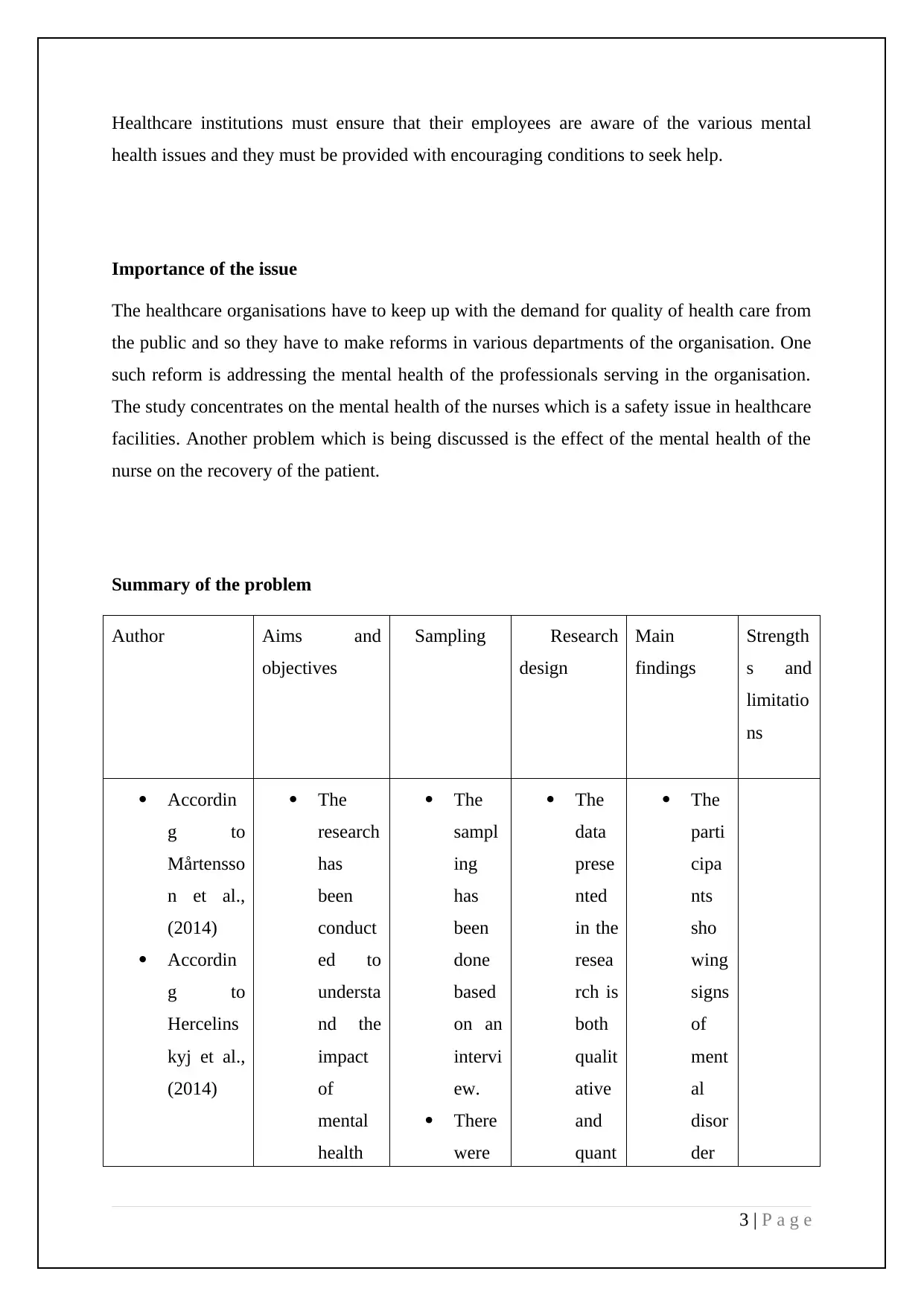
Healthcare institutions must ensure that their employees are aware of the various mental
health issues and they must be provided with encouraging conditions to seek help.
Importance of the issue
The healthcare organisations have to keep up with the demand for quality of health care from
the public and so they have to make reforms in various departments of the organisation. One
such reform is addressing the mental health of the professionals serving in the organisation.
The study concentrates on the mental health of the nurses which is a safety issue in healthcare
facilities. Another problem which is being discussed is the effect of the mental health of the
nurse on the recovery of the patient.
Summary of the problem
Author Aims and
objectives
Sampling Research
design
Main
findings
Strength
s and
limitatio
ns
Accordin
g to
Mårtensso
n et al.,
(2014)
Accordin
g to
Hercelins
kyj et al.,
(2014)
The
research
has
been
conduct
ed to
understa
nd the
impact
of
mental
health
The
sampl
ing
has
been
done
based
on an
intervi
ew.
There
were
The
data
prese
nted
in the
resea
rch is
both
qualit
ative
and
quant
The
parti
cipa
nts
sho
wing
signs
of
ment
al
disor
der
3 | P a g e
health issues and they must be provided with encouraging conditions to seek help.
Importance of the issue
The healthcare organisations have to keep up with the demand for quality of health care from
the public and so they have to make reforms in various departments of the organisation. One
such reform is addressing the mental health of the professionals serving in the organisation.
The study concentrates on the mental health of the nurses which is a safety issue in healthcare
facilities. Another problem which is being discussed is the effect of the mental health of the
nurse on the recovery of the patient.
Summary of the problem
Author Aims and
objectives
Sampling Research
design
Main
findings
Strength
s and
limitatio
ns
Accordin
g to
Mårtensso
n et al.,
(2014)
Accordin
g to
Hercelins
kyj et al.,
(2014)
The
research
has
been
conduct
ed to
understa
nd the
impact
of
mental
health
The
sampl
ing
has
been
done
based
on an
intervi
ew.
There
were
The
data
prese
nted
in the
resea
rch is
both
qualit
ative
and
quant
The
parti
cipa
nts
sho
wing
signs
of
ment
al
disor
der
3 | P a g e
Paraphrase This Document
Need a fresh take? Get an instant paraphrase of this document with our AI Paraphraser
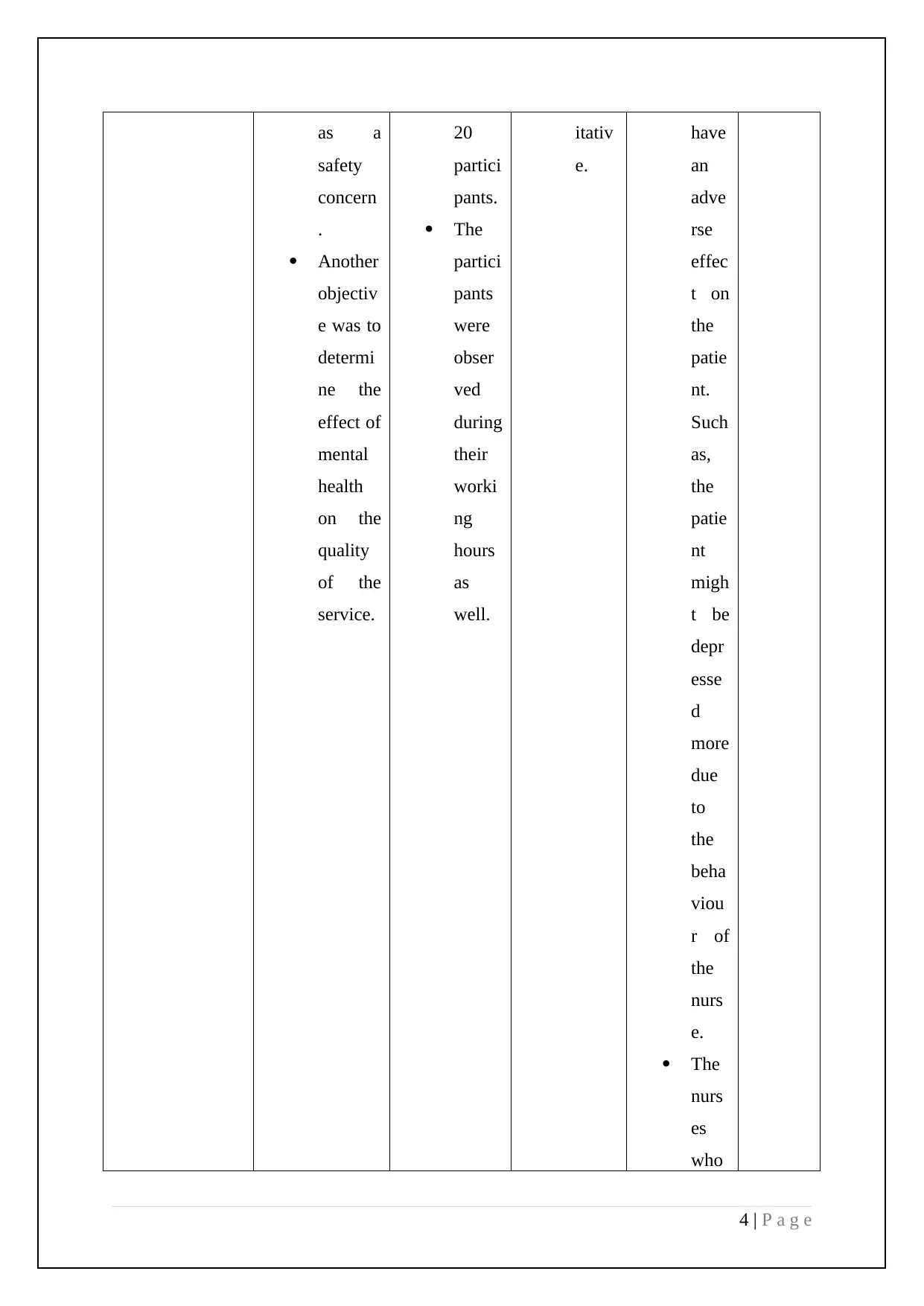
as a
safety
concern
.
Another
objectiv
e was to
determi
ne the
effect of
mental
health
on the
quality
of the
service.
20
partici
pants.
The
partici
pants
were
obser
ved
during
their
worki
ng
hours
as
well.
itativ
e.
have
an
adve
rse
effec
t on
the
patie
nt.
Such
as,
the
patie
nt
migh
t be
depr
esse
d
more
due
to
the
beha
viou
r of
the
nurs
e.
The
nurs
es
who
4 | P a g e
safety
concern
.
Another
objectiv
e was to
determi
ne the
effect of
mental
health
on the
quality
of the
service.
20
partici
pants.
The
partici
pants
were
obser
ved
during
their
worki
ng
hours
as
well.
itativ
e.
have
an
adve
rse
effec
t on
the
patie
nt.
Such
as,
the
patie
nt
migh
t be
depr
esse
d
more
due
to
the
beha
viou
r of
the
nurs
e.
The
nurs
es
who
4 | P a g e

have
sho
wn
signs
of
dang
erou
s
ment
al
disor
ders
such
as
pers
onali
ty
disor
der
can
be a
safet
y
issue
for
the
patie
nts.
5 | P a g e
sho
wn
signs
of
dang
erou
s
ment
al
disor
ders
such
as
pers
onali
ty
disor
der
can
be a
safet
y
issue
for
the
patie
nts.
5 | P a g e
⊘ This is a preview!⊘
Do you want full access?
Subscribe today to unlock all pages.

Trusted by 1+ million students worldwide
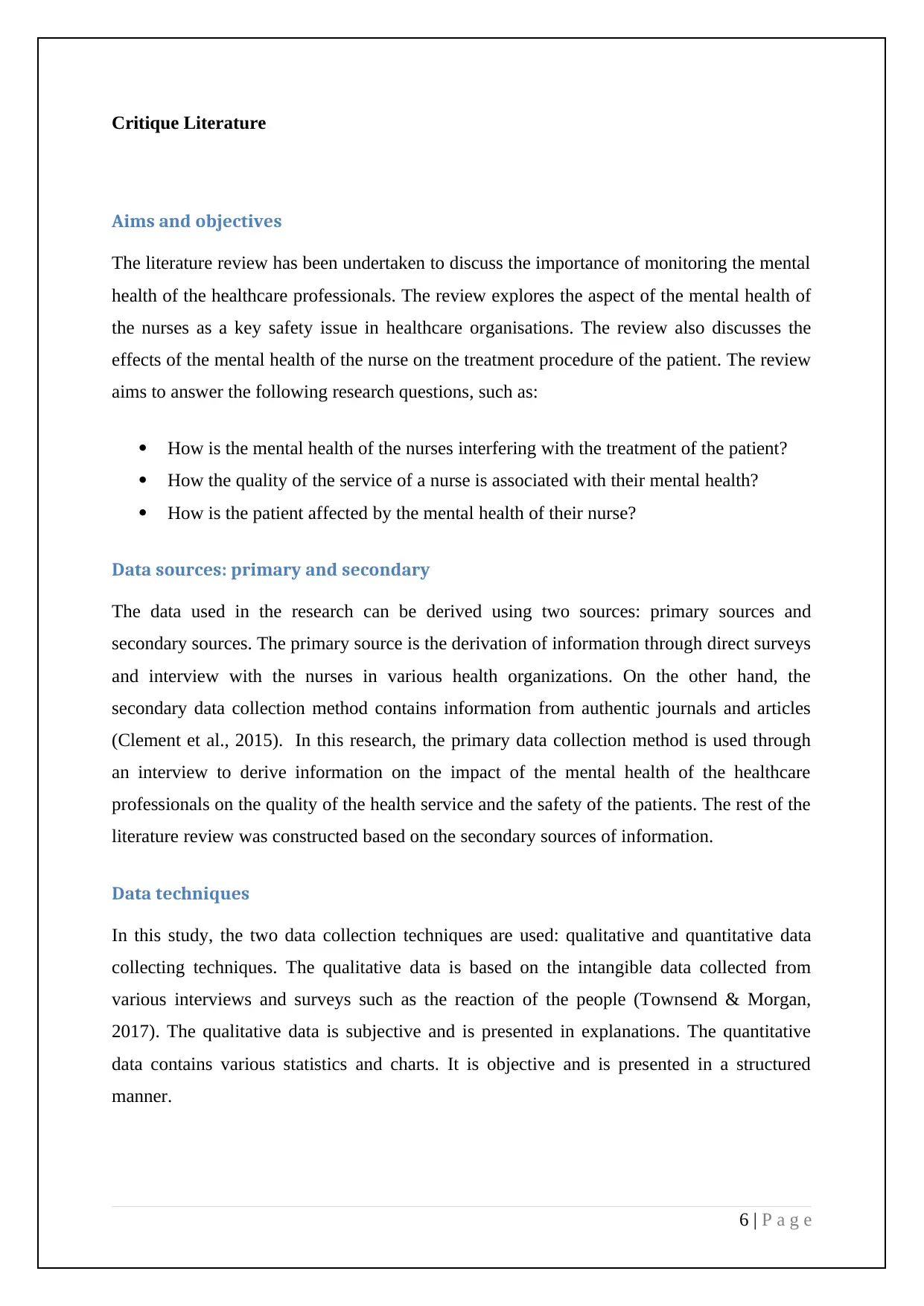
Critique Literature
Aims and objectives
The literature review has been undertaken to discuss the importance of monitoring the mental
health of the healthcare professionals. The review explores the aspect of the mental health of
the nurses as a key safety issue in healthcare organisations. The review also discusses the
effects of the mental health of the nurse on the treatment procedure of the patient. The review
aims to answer the following research questions, such as:
How is the mental health of the nurses interfering with the treatment of the patient?
How the quality of the service of a nurse is associated with their mental health?
How is the patient affected by the mental health of their nurse?
Data sources: primary and secondary
The data used in the research can be derived using two sources: primary sources and
secondary sources. The primary source is the derivation of information through direct surveys
and interview with the nurses in various health organizations. On the other hand, the
secondary data collection method contains information from authentic journals and articles
(Clement et al., 2015). In this research, the primary data collection method is used through
an interview to derive information on the impact of the mental health of the healthcare
professionals on the quality of the health service and the safety of the patients. The rest of the
literature review was constructed based on the secondary sources of information.
Data techniques
In this study, the two data collection techniques are used: qualitative and quantitative data
collecting techniques. The qualitative data is based on the intangible data collected from
various interviews and surveys such as the reaction of the people (Townsend & Morgan,
2017). The qualitative data is subjective and is presented in explanations. The quantitative
data contains various statistics and charts. It is objective and is presented in a structured
manner.
6 | P a g e
Aims and objectives
The literature review has been undertaken to discuss the importance of monitoring the mental
health of the healthcare professionals. The review explores the aspect of the mental health of
the nurses as a key safety issue in healthcare organisations. The review also discusses the
effects of the mental health of the nurse on the treatment procedure of the patient. The review
aims to answer the following research questions, such as:
How is the mental health of the nurses interfering with the treatment of the patient?
How the quality of the service of a nurse is associated with their mental health?
How is the patient affected by the mental health of their nurse?
Data sources: primary and secondary
The data used in the research can be derived using two sources: primary sources and
secondary sources. The primary source is the derivation of information through direct surveys
and interview with the nurses in various health organizations. On the other hand, the
secondary data collection method contains information from authentic journals and articles
(Clement et al., 2015). In this research, the primary data collection method is used through
an interview to derive information on the impact of the mental health of the healthcare
professionals on the quality of the health service and the safety of the patients. The rest of the
literature review was constructed based on the secondary sources of information.
Data techniques
In this study, the two data collection techniques are used: qualitative and quantitative data
collecting techniques. The qualitative data is based on the intangible data collected from
various interviews and surveys such as the reaction of the people (Townsend & Morgan,
2017). The qualitative data is subjective and is presented in explanations. The quantitative
data contains various statistics and charts. It is objective and is presented in a structured
manner.
6 | P a g e
Paraphrase This Document
Need a fresh take? Get an instant paraphrase of this document with our AI Paraphraser
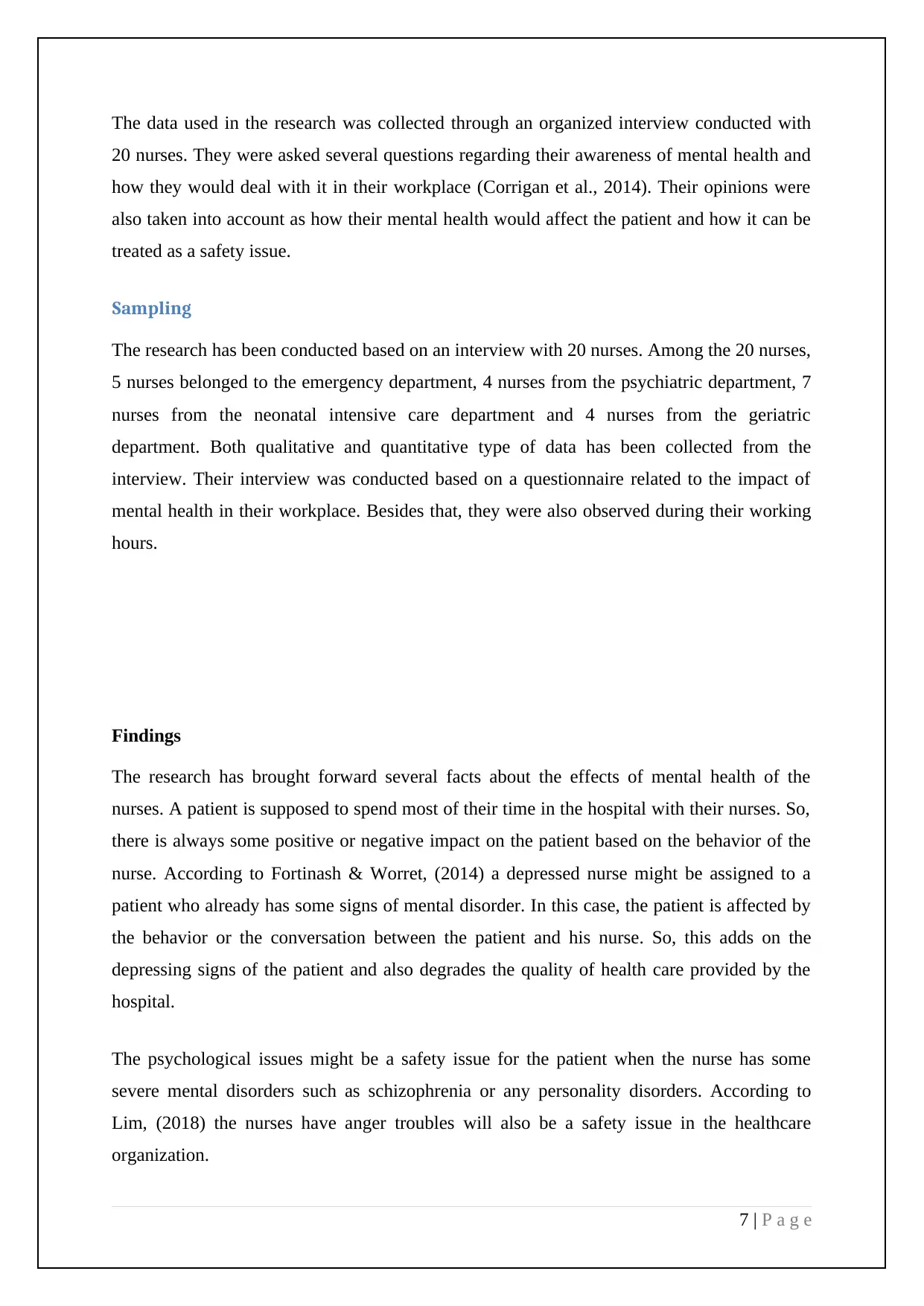
The data used in the research was collected through an organized interview conducted with
20 nurses. They were asked several questions regarding their awareness of mental health and
how they would deal with it in their workplace (Corrigan et al., 2014). Their opinions were
also taken into account as how their mental health would affect the patient and how it can be
treated as a safety issue.
Sampling
The research has been conducted based on an interview with 20 nurses. Among the 20 nurses,
5 nurses belonged to the emergency department, 4 nurses from the psychiatric department, 7
nurses from the neonatal intensive care department and 4 nurses from the geriatric
department. Both qualitative and quantitative type of data has been collected from the
interview. Their interview was conducted based on a questionnaire related to the impact of
mental health in their workplace. Besides that, they were also observed during their working
hours.
Findings
The research has brought forward several facts about the effects of mental health of the
nurses. A patient is supposed to spend most of their time in the hospital with their nurses. So,
there is always some positive or negative impact on the patient based on the behavior of the
nurse. According to Fortinash & Worret, (2014) a depressed nurse might be assigned to a
patient who already has some signs of mental disorder. In this case, the patient is affected by
the behavior or the conversation between the patient and his nurse. So, this adds on the
depressing signs of the patient and also degrades the quality of health care provided by the
hospital.
The psychological issues might be a safety issue for the patient when the nurse has some
severe mental disorders such as schizophrenia or any personality disorders. According to
Lim, (2018) the nurses have anger troubles will also be a safety issue in the healthcare
organization.
7 | P a g e
20 nurses. They were asked several questions regarding their awareness of mental health and
how they would deal with it in their workplace (Corrigan et al., 2014). Their opinions were
also taken into account as how their mental health would affect the patient and how it can be
treated as a safety issue.
Sampling
The research has been conducted based on an interview with 20 nurses. Among the 20 nurses,
5 nurses belonged to the emergency department, 4 nurses from the psychiatric department, 7
nurses from the neonatal intensive care department and 4 nurses from the geriatric
department. Both qualitative and quantitative type of data has been collected from the
interview. Their interview was conducted based on a questionnaire related to the impact of
mental health in their workplace. Besides that, they were also observed during their working
hours.
Findings
The research has brought forward several facts about the effects of mental health of the
nurses. A patient is supposed to spend most of their time in the hospital with their nurses. So,
there is always some positive or negative impact on the patient based on the behavior of the
nurse. According to Fortinash & Worret, (2014) a depressed nurse might be assigned to a
patient who already has some signs of mental disorder. In this case, the patient is affected by
the behavior or the conversation between the patient and his nurse. So, this adds on the
depressing signs of the patient and also degrades the quality of health care provided by the
hospital.
The psychological issues might be a safety issue for the patient when the nurse has some
severe mental disorders such as schizophrenia or any personality disorders. According to
Lim, (2018) the nurses have anger troubles will also be a safety issue in the healthcare
organization.
7 | P a g e
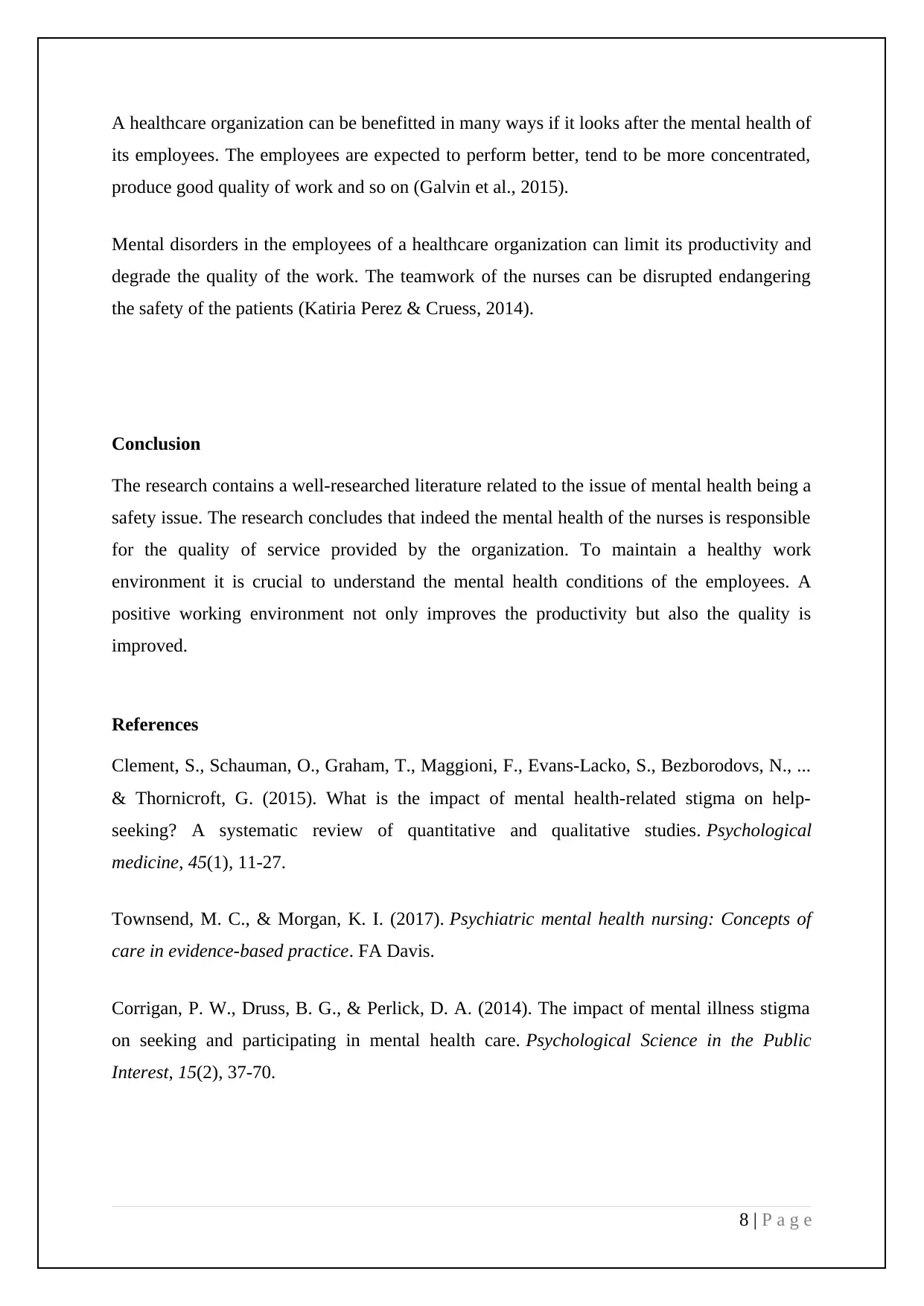
A healthcare organization can be benefitted in many ways if it looks after the mental health of
its employees. The employees are expected to perform better, tend to be more concentrated,
produce good quality of work and so on (Galvin et al., 2015).
Mental disorders in the employees of a healthcare organization can limit its productivity and
degrade the quality of the work. The teamwork of the nurses can be disrupted endangering
the safety of the patients (Katiria Perez & Cruess, 2014).
Conclusion
The research contains a well-researched literature related to the issue of mental health being a
safety issue. The research concludes that indeed the mental health of the nurses is responsible
for the quality of service provided by the organization. To maintain a healthy work
environment it is crucial to understand the mental health conditions of the employees. A
positive working environment not only improves the productivity but also the quality is
improved.
References
Clement, S., Schauman, O., Graham, T., Maggioni, F., Evans-Lacko, S., Bezborodovs, N., ...
& Thornicroft, G. (2015). What is the impact of mental health-related stigma on help-
seeking? A systematic review of quantitative and qualitative studies. Psychological
medicine, 45(1), 11-27.
Townsend, M. C., & Morgan, K. I. (2017). Psychiatric mental health nursing: Concepts of
care in evidence-based practice. FA Davis.
Corrigan, P. W., Druss, B. G., & Perlick, D. A. (2014). The impact of mental illness stigma
on seeking and participating in mental health care. Psychological Science in the Public
Interest, 15(2), 37-70.
8 | P a g e
its employees. The employees are expected to perform better, tend to be more concentrated,
produce good quality of work and so on (Galvin et al., 2015).
Mental disorders in the employees of a healthcare organization can limit its productivity and
degrade the quality of the work. The teamwork of the nurses can be disrupted endangering
the safety of the patients (Katiria Perez & Cruess, 2014).
Conclusion
The research contains a well-researched literature related to the issue of mental health being a
safety issue. The research concludes that indeed the mental health of the nurses is responsible
for the quality of service provided by the organization. To maintain a healthy work
environment it is crucial to understand the mental health conditions of the employees. A
positive working environment not only improves the productivity but also the quality is
improved.
References
Clement, S., Schauman, O., Graham, T., Maggioni, F., Evans-Lacko, S., Bezborodovs, N., ...
& Thornicroft, G. (2015). What is the impact of mental health-related stigma on help-
seeking? A systematic review of quantitative and qualitative studies. Psychological
medicine, 45(1), 11-27.
Townsend, M. C., & Morgan, K. I. (2017). Psychiatric mental health nursing: Concepts of
care in evidence-based practice. FA Davis.
Corrigan, P. W., Druss, B. G., & Perlick, D. A. (2014). The impact of mental illness stigma
on seeking and participating in mental health care. Psychological Science in the Public
Interest, 15(2), 37-70.
8 | P a g e
⊘ This is a preview!⊘
Do you want full access?
Subscribe today to unlock all pages.

Trusted by 1+ million students worldwide
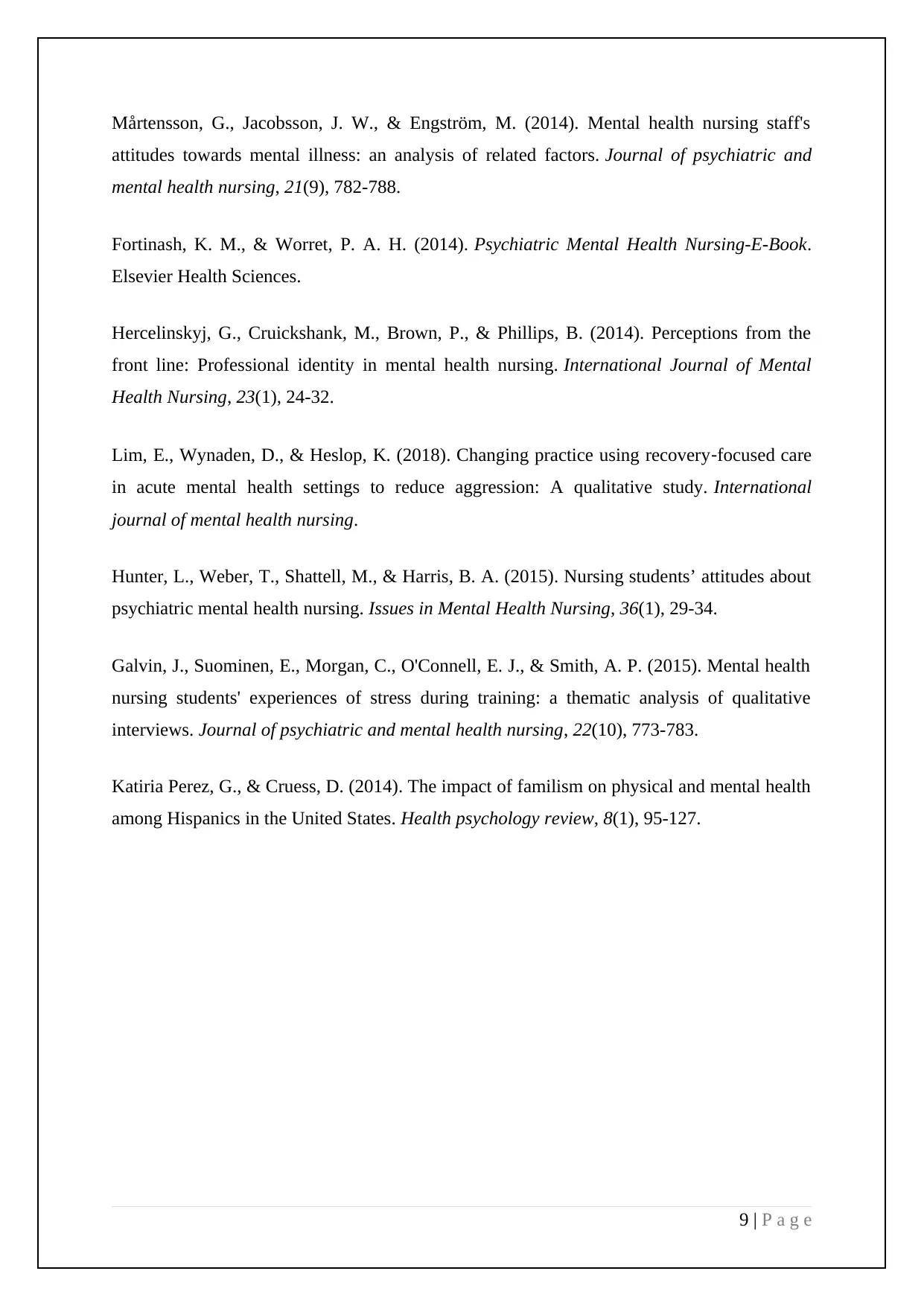
Mårtensson, G., Jacobsson, J. W., & Engström, M. (2014). Mental health nursing staff's
attitudes towards mental illness: an analysis of related factors. Journal of psychiatric and
mental health nursing, 21(9), 782-788.
Fortinash, K. M., & Worret, P. A. H. (2014). Psychiatric Mental Health Nursing-E-Book.
Elsevier Health Sciences.
Hercelinskyj, G., Cruickshank, M., Brown, P., & Phillips, B. (2014). Perceptions from the
front line: Professional identity in mental health nursing. International Journal of Mental
Health Nursing, 23(1), 24-32.
Lim, E., Wynaden, D., & Heslop, K. (2018). Changing practice using recovery‐focused care
in acute mental health settings to reduce aggression: A qualitative study. International
journal of mental health nursing.
Hunter, L., Weber, T., Shattell, M., & Harris, B. A. (2015). Nursing students’ attitudes about
psychiatric mental health nursing. Issues in Mental Health Nursing, 36(1), 29-34.
Galvin, J., Suominen, E., Morgan, C., O'Connell, E. J., & Smith, A. P. (2015). Mental health
nursing students' experiences of stress during training: a thematic analysis of qualitative
interviews. Journal of psychiatric and mental health nursing, 22(10), 773-783.
Katiria Perez, G., & Cruess, D. (2014). The impact of familism on physical and mental health
among Hispanics in the United States. Health psychology review, 8(1), 95-127.
9 | P a g e
attitudes towards mental illness: an analysis of related factors. Journal of psychiatric and
mental health nursing, 21(9), 782-788.
Fortinash, K. M., & Worret, P. A. H. (2014). Psychiatric Mental Health Nursing-E-Book.
Elsevier Health Sciences.
Hercelinskyj, G., Cruickshank, M., Brown, P., & Phillips, B. (2014). Perceptions from the
front line: Professional identity in mental health nursing. International Journal of Mental
Health Nursing, 23(1), 24-32.
Lim, E., Wynaden, D., & Heslop, K. (2018). Changing practice using recovery‐focused care
in acute mental health settings to reduce aggression: A qualitative study. International
journal of mental health nursing.
Hunter, L., Weber, T., Shattell, M., & Harris, B. A. (2015). Nursing students’ attitudes about
psychiatric mental health nursing. Issues in Mental Health Nursing, 36(1), 29-34.
Galvin, J., Suominen, E., Morgan, C., O'Connell, E. J., & Smith, A. P. (2015). Mental health
nursing students' experiences of stress during training: a thematic analysis of qualitative
interviews. Journal of psychiatric and mental health nursing, 22(10), 773-783.
Katiria Perez, G., & Cruess, D. (2014). The impact of familism on physical and mental health
among Hispanics in the United States. Health psychology review, 8(1), 95-127.
9 | P a g e
1 out of 10
Related Documents
Your All-in-One AI-Powered Toolkit for Academic Success.
+13062052269
info@desklib.com
Available 24*7 on WhatsApp / Email
![[object Object]](/_next/static/media/star-bottom.7253800d.svg)
Unlock your academic potential
Copyright © 2020–2025 A2Z Services. All Rights Reserved. Developed and managed by ZUCOL.





